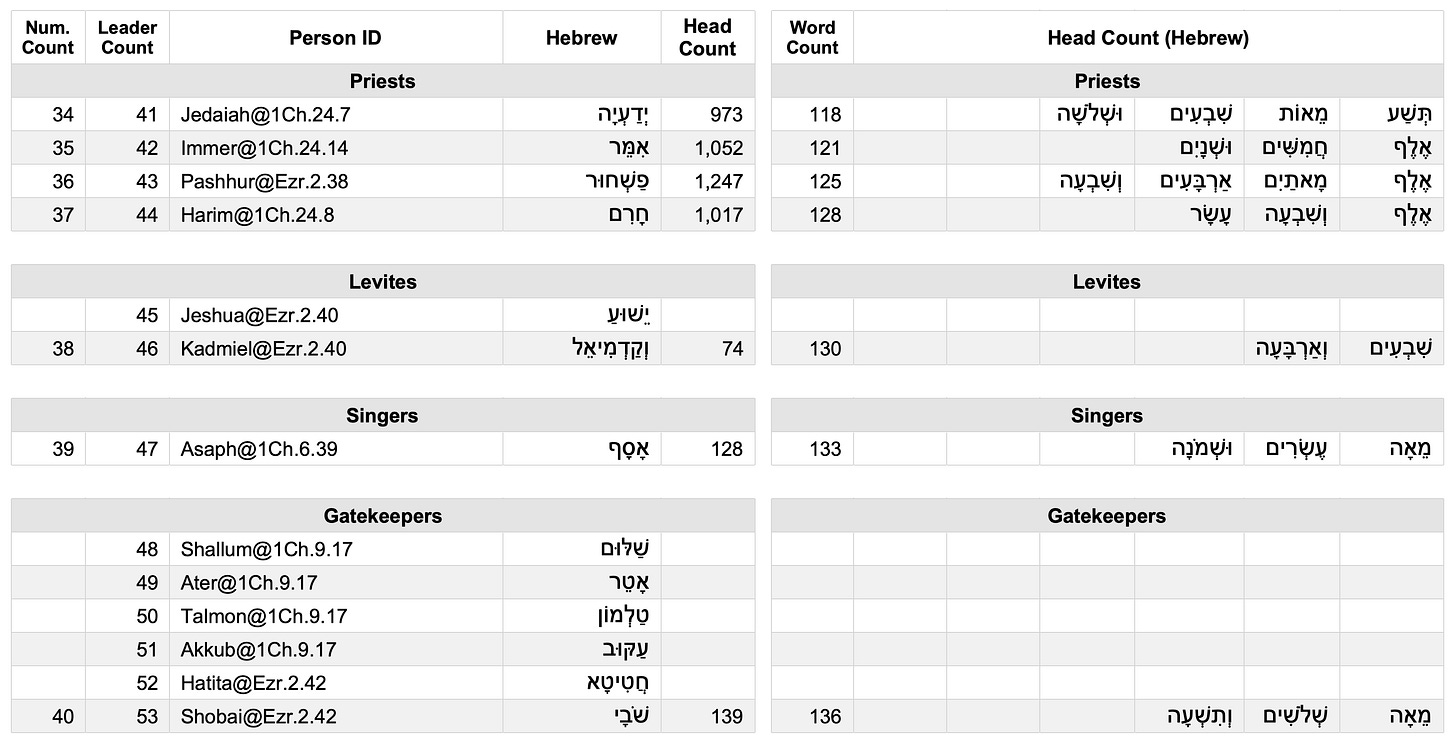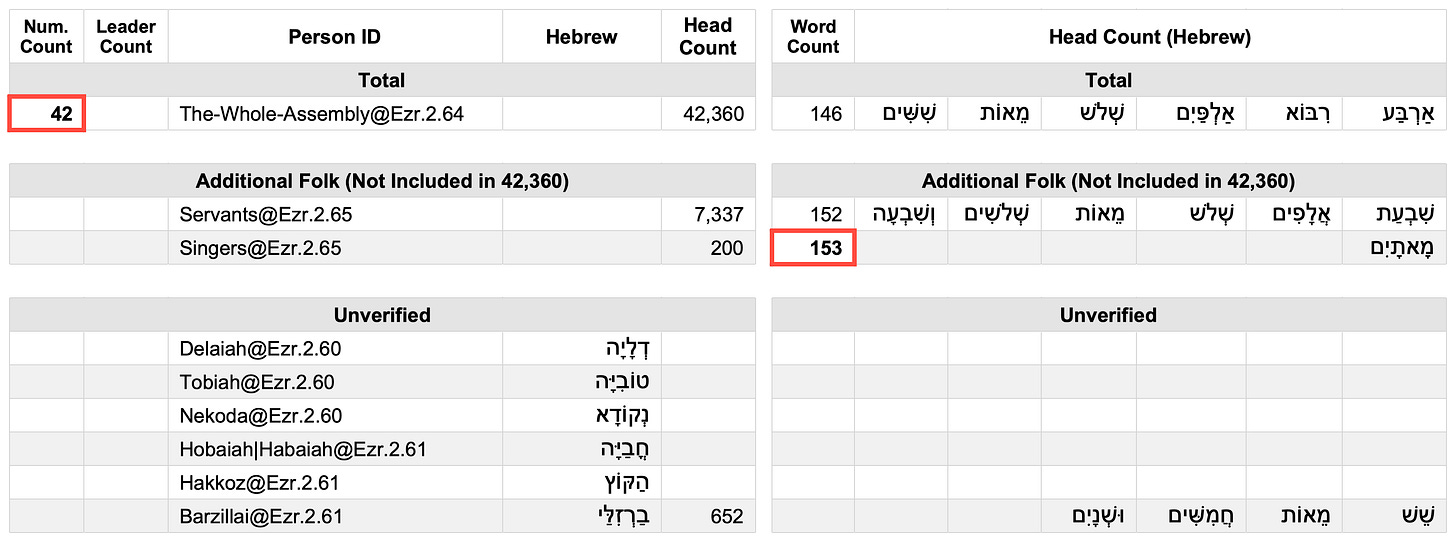Ezra 2’s list of clans deserves serious attention. Consider, for a start, some of its numerical properties.
It begins with the classic introduction to Biblical lists of people, viz. ‘Now these...’ (וְאֵלֶּה), which has a gematrial value of 42.
Its historical purpose is to detail the community membership of a total of 42,000 individuals (to the nearest thousand) (2.64).
Its main body includes 42 head-counts.
Its list of Temple staff consists of 42 clans (35 clans of Temple servants, 6 clans of gatekeepers, and one clan of singers).
And its lowest number happens to be 42—that is to say, its smallest clan consists of 42 individuals. (Note: My calculations exclude the clans listed in 2.59–62, since those clans are explicitly said to have been unable to document their ancestry, given which their priests were excluded from the priesthood. For details, see the Appendix.)
Also worthy of note is the text of Ezra 8, where Ezra describes the company of men whom he leads back from Babylon in terms of 42 named entities.1
That Ezra 2 is built around the number 42 is significant, since the number 42 is connected with the climax of a Jubilee cycle, which is precisely what Ezra 2 describes. Below, I’ll explain how.
The Number 42, the Jubilee, and Ergo the Text of Ezra 2
Consider a few notable properties of the number 42
Scripture views half a week of years as ‘42 months’ (e.g., Rev. 11.2, 13.5), which anticipates the completion of a full week (and ultimately of a week of weeks).2
The number 42 is made up of six groups of seven (6 x 7), in which respect it anticipates a seventh week, i.e., the climax of a Jubilee cycle.
The Gospels depict the arrival of the Messiah as the culmination of both a 42-generation genealogy and a 84-year wait (42 x 2 years) (hence Jesus’ announcement of ‘the year of the Lord’s favour’: Luke 4.19).
And 42 happens to be the gematrial value of the word ‘Jubilee’ (יֹבֵל).
The number 42 is thus distinctly Jubilee-esque. Meanwhile, the text of Ezra is (canonically) intended to signal a second Jubilee moment in Israel’s history. Consider, by way of illustration, the shape of the book of Chronicles and the way in which it flows into the book of Ezra: in chs. 1–9, the twelve tribes are settled in their respective territories (in literary terms); in the main body of the book, the Israelites’ unity slowly disintegrates; the book comes to its climax with the rise of Jehoiachin and his generation—the 49th from Adam; and the book’s final paragraph describes the return of the next generation to their homeland (2 Chr. 36). Then, in the book of Ezra, each man is said to ‘settle in his own town’ (Ezra 2.1) in true Jubilee fashion.
The text of Ezra thus depicts a fresh start for Israel—the inauguration of a second Jubilee cycle in the nation’s history. And these notions are embodied in the numerical properties of Ezra’s clan list:
Ezra’s clans are headed up by twelve leaders (1.11–2.2), which serves to portray them as a new Israel.
Ezra’s list consists of 98 clans, i.e., a double-Jubilees’ worth (2.3–57).
And the total head-count of Ezra’s assembly amounts to 42,360, which is noteworthy since 42 is the gematrial value of ‘Jubilee’ (as we have seen) and 360 is the value of ‘second’ (שֵׁנִי).
That point is underlined by the numerical properties of the Gospel of John:
John is built around a Jubilee-esque chronological framework, as I’ve sought to show here.
John has a particular interest in Jesus’ selection and preservation of ‘the twelve’ (cp. John 6.67ff. with 6.39, 18.9), which resonates with Ezra’s twelve leaders.
John refers to Jesus’ disciples by name 98 times (cp. below), which resonates with Ezra’s 98 named clans.
And the numbers associated with Ezra’s list of clans are spelt out by means of exactly 153 Hebrew words, which resonates with John’s count of 153 fish at the end of his Gospel. (Note: In my calculations, I’ve excluded surnames—e.g., I’ve only counted ‘Judas Iscariot’ as a single name occurrence; similarly, in the case of Ezra’s clan names, I’ve excluded higher level clans—e.g., I’ve only counted ‘the sons of Pahath-Moab, namely of Jeshua and Joab’ as two clan names [‘Jeshua’ and ‘Joab’] rather than three.)
Viewed against the backdrop of Ezra, then, John’s epilogue anticipates the formation of a new covenant community (the Church), which it sees as the culmination of a long, Jubilee-shaped sweep of history. And that community, John tells us, will ‘gather into one’ (cp. John 11.52’s εἰς ἕν with Ezra 2.64’s כְּאֶחָד) ‘all the children of God’—a phrase which seems particularly apt in light of the gematrial value of the Hebrew for ‘children of God’ (בְּנֵי הָאֱלֹהִים), viz. 153.
Appendix: Calculations
In Scripture, lists of people are often presented in such a way as to allow different totals to be generated from them. A well known example is Jacob’s genealogy (set out in Genesis 46), from which Moses initially generates a total of 66 and later generates a total of 70 by means of the inclusion of Joseph and his sons (who are already in Egypt) (on which see here).
Ezra’s clan list is constructed in a similar fashion. It consists of 98 clan names (as defined above). It includes 42 head-counts. And these 42 head-counts, together with the text’s appended list of servants (which are not included in the head-count of 42,360), are spelt out by means of 153 Hebrew words. The details are as follows.
Ezra begins with a list of 40 clans which are not connected with the Temple service, as shown below. The first column is a tally of the head-counts; the second is a tally of the clan names.
Afterwards, Ezra lists 13 clans of priests, Levites, singers, and gatekeepers.
Next, Ezra lists 45 clans of servants. These divide into 35 clans of Temple servants, shown below,
…followed by 10 clans known as ‘Solomon’s servants’.
The relevant totals for Ezra’s clan list are thus as follows:
Meanwhile, the calculations for John are detailed in the table below.
Ezra 8 describes the company of men in terms of 16 named individuals, who represent 12 named clans (8.1–14), and he later singles 11 men whom he sends to fetch three named companies of priests (8.16-20), which brings the total number of names to 42.
Note how the 42 months of Revelation 11 lead up to the moment when the seventh angel blows his trumpet (shofar?) and declares God’s ownership of the earth (‘The kingdom of the world has become the kingdom of our Lord!’), which is of course the foundational principle of the Jubilee, viz. ‘The land shall not be sold in perpetuity, for the land is mine!’ (Lev. 25.23). Like the Israelites, we are mere tenants.












Fascinating stuff. Is this part of a wider project on Ezra? I notice your last post has some overlap with this post-exilic period.